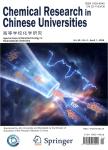Syntheses, Structures and Magnetic Properties of Two Coordination Polymers Based on 2,2-Biphenyldicarboxylate Ligand
Syntheses, Structures and Magnetic Properties of Two Coordination Polymers Based on 2,2-Biphenyldicarboxylate Ligand作者机构:Shandong Provincial Key Laboratory of Chemical Energy Storage and Novel Cell Technology School of Chemistry and Chemical Engineering Liaocheng University Liaocheng 252059 P R. China
出 版 物:《Chemical Research in Chinese Universities》 (高等学校化学研究(英文版))
年 卷 期:2016年第32卷第2期
页 面:165-171页
核心收录:
学科分类:080801[工学-电机与电器] 081704[工学-应用化学] 0808[工学-电气工程] 07[理学] 08[工学] 0817[工学-化学工程与技术] 0805[工学-材料科学与工程(可授工学、理学学位)] 080502[工学-材料学] 0703[理学-化学] 070301[理学-无机化学]
基 金:Supported by the National Natural Science Foundation of China(No.21101086)
主 题:Coordination polymer Crystal structure Magnetic property
摘 要:Two coordination polymers {[Co3L3(Me2NH)2]·(Me2NH)}n(1) and [CuL(bpy)],(2)(L=2,2'-biphenyl dicarboxylate ion, bpy=4,4'-bipyridine) were obtained and characterized. Compound 1 was synthesised via solvotherreal method, with the L ligands adopting syn-syn-μ2-η1:η1- and μ2-η2-coordination modes and Co(II) centers being linked to form a 1D coordination chain with trinuclear Co3 cluster as sub-units. Compound 2 was synthesized at room temperature, with the L ligand chelating the Cu(II) centers to form a 1D chain, which was further linked by the auxiliary 4,4'-bpy ligand to form a 3D coordination network. The results of variable temperature susceptibility studies reveal that there were ferromagnetic and antiferromagnetic interactions between the paramagnetic metal centers in compounds 1 and 2, respectively.



